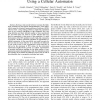Free Online Productivity Tools
i2Speak
i2Symbol
i2OCR
iTex2Img
iWeb2Print
iWeb2Shot
i2Type
iPdf2Split
iPdf2Merge
i2Bopomofo
i2Arabic
i2Style
i2Image
i2PDF
iLatex2Rtf
Sci2ools
CEC
2011
IEEE
2011
IEEE
Modeling HIV spread through sexual contact using a cellular automaton
Abstract—Having a risky sexual behavior increases the likelihood of infection by the Human Immunodeficiency Virus (HIV), which causes the Acquired Immunodeficiency Syndrome (AIDS). This has been a long lasting problem in high-risk populations such as sex workers: individuals in this population may face drug addiction and share infected needles, or have unprotected sex, and both issues can result in an HIV infection that may then be transmitted to other parts of the population. To study the dynamics of the HIV epidemic in such a high-risk community, we propose a model in which the population is represented as a cellular automaton. At the macro-level, our model accounts for the fact that the sexual behavior of an individual is influenced by the social norms of his acquaintances (social network) as well as by his awareness of HIV status. At the micro-level, randomized neighborhoods provide an explicit representation of personal interactions standing for the large number of nonrepeate...
| Added | 13 Dec 2011 |
| Updated | 13 Dec 2011 |
| Type | Journal |
| Year | 2011 |
| Where | CEC |
| Authors | Azadeh Alimadad, Vahid Dabbaghian, Suraj K. Singhk, Herbert H. Tsang |
Comments (0)

